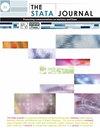kpsstest:使用特定于样本的临界值实现Kwiatkowski、Phillips、Schmidt和Shin检验并报告p值的命令
IF 3.2
2区 数学
Q1 SOCIAL SCIENCES, MATHEMATICAL METHODS
引用次数: 4
摘要
时间序列分析中常用的单位根检验,如Dickey–Fuller和Phillips–Perron检验,使用序列包含单位根的零假设。当时间序列接近积分或高度自回归时,这种测试相对于另一种测试的功率较低,这意味着它们在区分这种序列与具有单位根方面做得很差。Kwiatkowski等人(1992,Journal of Econometrics 54:159–178)引入了Kwiatkovski、Phillips、Schmidt和Shin检验,其中零假设是序列是平稳的,以处理这个问题。Stata中目前可用的Kwiatkowski、Phillips、Schmidt和Shin检验的一个缺点是,无论样本大小,它都使用渐近临界值。这带来了一个问题,因为研究人员——尤其是社会科学家——经常被呈现出短时间序列。我介绍了kpsstest,这是一个命令,它扩展了以前的实现,包括零均值平稳零假设的选项,生成样本和测试特定的临界值,并报告适当的p值。本文章由计算机程序翻译,如有差异,请以英文原文为准。
kpsstest: A command that implements the Kwiatkowski, Phillips, Schmidt, and Shin test with sample-specific critical values and reports p-values
Commonly used unit-root tests in time-series analysis—such as the Dickey–Fuller and Phillips–Perron tests—use a null hypothesis that the series contains a unit root. Such tests have low power against the alternative—when a time series is near integrated or highly autoregressive—implying that they do poorly in distinguishing such a series from having a unit root. Kwiatkowski et al. (1992, Journal of Econometrics 54: 159–178) introduced the Kwiatkowski, Phillips, Schmidt, and Shin test, in which the null hypothesis is that the series is stationary, to deal with this problem. One shortcoming of the presently available Kwiatkowski, Phillips, Schmidt, and Shin test in Stata is that it uses asymptotic critical values regardless of the sample size. This poses a problem in that researchers—especially social scientists—are often presented with short time series. I introduce kpsstest, a command that extends the previous implementation by including an option for a zero-mean-stationary null hypothesis, generating sample and test-specific critical values, and reporting appropriate p-values.
求助全文
通过发布文献求助,成功后即可免费获取论文全文。
去求助
来源期刊

Stata Journal
数学-统计学与概率论
CiteScore
7.80
自引率
4.20%
发文量
44
审稿时长
>12 weeks
期刊介绍:
The Stata Journal is a quarterly publication containing articles about statistics, data analysis, teaching methods, and effective use of Stata''s language. The Stata Journal publishes reviewed papers together with shorter notes and comments, regular columns, book reviews, and other material of interest to researchers applying statistics in a variety of disciplines.
 求助内容:
求助内容: 应助结果提醒方式:
应助结果提醒方式:


